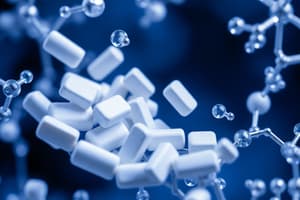Podcast
Questions and Answers
What happens to the drug in SDDS after it comes into contact with GI fluids?
What happens to the drug in SDDS after it comes into contact with GI fluids?
- It remains in a supersaturated concentration
- It forms a micelle
- It precipitates out of the solution
- It springs into the system and then slowly returns (correct)
What is the role of polymers in SDDS?
What is the role of polymers in SDDS?
- To form a micelle with the surfactant
- To enhance the lipophilicity of the drug
- To increase the viscosity of the solution
- To prevent precipitation of the drug (correct)
What is the name of the cancer drug that is dissolved in PEG 400?
What is the name of the cancer drug that is dissolved in PEG 400?
- Bexarotene (correct)
- Voriconazole
- Etoposide
- Ethosuximide
What is the purpose of cosolvents in improving bioavailability?
What is the purpose of cosolvents in improving bioavailability?
What is the result of micellar solubilization?
What is the result of micellar solubilization?
What is the composition of cyclodextrins?
What is the composition of cyclodextrins?
What is the purpose of using surfactants in micellar solubilization?
What is the purpose of using surfactants in micellar solubilization?
What is the result of drug precipitation in SDDS?
What is the result of drug precipitation in SDDS?
What is the final form of the drug in SEDDS after it comes into contact with aqueous medium?
What is the final form of the drug in SEDDS after it comes into contact with aqueous medium?
What is the primary purpose of BA/BE studies in drug development?
What is the primary purpose of BA/BE studies in drug development?
What is the primary purpose of assessing bioavailability?
What is the primary purpose of assessing bioavailability?
What is the assumption made in urinary excretion curve studies?
What is the assumption made in urinary excretion curve studies?
What type of studies are needed for INDs, NDAs, ANDAs, and their amendments and supplements?
What type of studies are needed for INDs, NDAs, ANDAs, and their amendments and supplements?
What is the formula to calculate absolute bioavailability?
What is the formula to calculate absolute bioavailability?
What can be estimated from BA studies?
What can be estimated from BA studies?
What is the purpose of relative bioavailability studies?
What is the purpose of relative bioavailability studies?
What is the purpose of BE studies in ANDA submissions?
What is the purpose of BE studies in ANDA submissions?
What affects the bioavailability of a drug?
What affects the bioavailability of a drug?
When are BE studies necessary?
When are BE studies necessary?
What is the purpose of bioequivalence studies?
What is the purpose of bioequivalence studies?
What is the recommended approach for bioequivalence studies as per FDA guidelines?
What is the recommended approach for bioequivalence studies as per FDA guidelines?
What is the purpose of documenting BE?
What is the purpose of documenting BE?
What is the assumption made in plasma concentration-time curve studies?
What is the assumption made in plasma concentration-time curve studies?
When is a BE study required?
When is a BE study required?
What is the purpose of assessing the urinary excretion curve?
What is the purpose of assessing the urinary excretion curve?
What is the classification of drugs based on?
What is the classification of drugs based on?
What is the primary focus of BA studies?
What is the primary focus of BA studies?
Which of the following conditions may waive the requirement for in vivo BA or BE?
Which of the following conditions may waive the requirement for in vivo BA or BE?
What is the main requirement for a solution to be considered self-evident in its bioavailability?
What is the main requirement for a solution to be considered self-evident in its bioavailability?
What is the purpose of referencing 21 CFR 320.21 in regulatory requirements?
What is the purpose of referencing 21 CFR 320.21 in regulatory requirements?
What type of drug product may be considered self-evident in its bioavailability based on its route of administration?
What type of drug product may be considered self-evident in its bioavailability based on its route of administration?
What is a key consideration for a solution to be considered self-evident in its bioavailability?
What is a key consideration for a solution to be considered self-evident in its bioavailability?
What type of evidence may be relied upon for certain drug products according to 21 CFR 320.22?
What type of evidence may be relied upon for certain drug products according to 21 CFR 320.22?
What is the purpose of referencing 21 CFR 320.22 in considerations for bioequivalence?
What is the purpose of referencing 21 CFR 320.22 in considerations for bioequivalence?
What is an example of a drug product that may be considered self-evident in its bioavailability?
What is an example of a drug product that may be considered self-evident in its bioavailability?
What is a key condition for a biowaiver based on BCS?
What is a key condition for a biowaiver based on BCS?
What is the primary site of drug metabolism in the liver?
What is the primary site of drug metabolism in the liver?
What is the name of the largest family of membrane-bound, non-specific, multifunctional enzymes involved in drug metabolism?
What is the name of the largest family of membrane-bound, non-specific, multifunctional enzymes involved in drug metabolism?
What is the result of the action of the mono-oxygenase system in drug metabolism?
What is the result of the action of the mono-oxygenase system in drug metabolism?
Which phase of drug metabolism involves the passage of drugs across the plasma membrane?
Which phase of drug metabolism involves the passage of drugs across the plasma membrane?
What is the primary function of Phase 1 reactions in drug metabolism?
What is the primary function of Phase 1 reactions in drug metabolism?
Which of the following enzymes is NOT involved in Phase 1 reactions?
Which of the following enzymes is NOT involved in Phase 1 reactions?
What is the primary function of Phase 2 reactions in drug metabolism?
What is the primary function of Phase 2 reactions in drug metabolism?
What is the role of influx transporters in drug metabolism?
What is the role of influx transporters in drug metabolism?
Which of the following is NOT a type of enzyme involved in Phase 1 reactions?
Which of the following is NOT a type of enzyme involved in Phase 1 reactions?
Flashcards are hidden until you start studying
Study Notes
Improving Bioavailability of Poorly Soluble Drugs
- Factors affecting bioavailability: lipophilicity, cosolvents, cyclodextrins, micellar solubilization, and self-emulsifying drug delivery systems (SEDDS)
- Cosolvents: low molecular weight, e.g., PEGs, PG, Glycerol, to dissolve drugs in soft gel capsules
- Examples of cosolvent-based formulations: Bexarotene (Targretin), Etoposide (VePesid), Ethosuximide (Zarontin)
Cyclodextrins
- Cyclic oligosaccharides composed of glucopyranose units
- Lipophilic molecules trapped inside cyclodextrins to increase aqueous solubility
- Example: Voriconazole (antifungal drug)
Micellar Solubilization
- Surfactants used to improve solubility of drugs, increasing bioavailability
- Used for both liquid and solid formulations
Self-Emulsifying Drug Delivery Systems (SEDDS)
- Drug solubilized in oil/surfactant vehicle, filled in a soft gelatin capsule
- Micro-emulsion or nano-emulsion results, with drug diffusing into the aqueous medium
Biopharmaceutical Properties
- Drug release, stability, permeability, and measurement of bioavailability
- Factors affecting bioavailability: pre-systemic metabolism, permeability, and release of drug
Assessment of Bioavailability
- Plasma concentration-time curve: measures rate and extent of absorption
- Urinary drug excretion curve: measures rate and extent of elimination
- Bioavailability: fraction of administered dose that reaches systemic circulation
- Absolute bioavailability: compares bioavailability of a drug via different routes of administration
- Relative bioavailability: compares bioavailability of a drug via different formulations
Bioequivalence Studies
- Important for drug development and regulatory approval
- Types of bioequivalence studies: in vivo, in vitro, and clinical trials
- Approaches: comparative pharmacokinetic studies, pharmacodynamic studies, clinical trials, and in vitro tests
Regulatory Requirements
- Refer to 21 CFR 320.21 for guidelines on bioavailability and bioequivalence studies
- Waivers: certain circumstances where bioavailability or bioequivalence studies may be waived
Considerations
- Self-evident bioavailability: certain drug products where bioavailability is obvious
- Biowaivers: certain situations where bioavailability studies may not be required
Drug Metabolism and Excretion
- Phases of metabolism: 0, 1, 2, and 3
- Phase 1: introduction of reactive groups, e.g., oxidation, hydrolysis
- Phase 2: transfer of polar groups, e.g., glucuronidation, sulfation
- Phase 3: transport outside, e.g., efflux transporters
Phase I Reactions
- Enzymes: oxygenases/oxidases, e.g., CYP450 isozymes, flavin-containing monooxygenases
- Examples of Phase I reactions: hydrolysis, oxidation, reduction, and cyclization
Studying That Suits You
Use AI to generate personalized quizzes and flashcards to suit your learning preferences.




